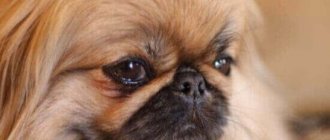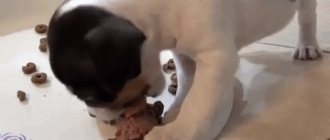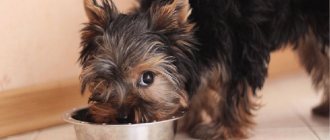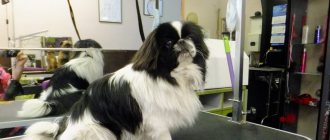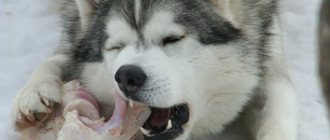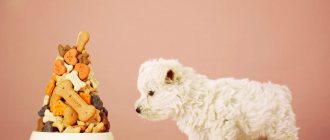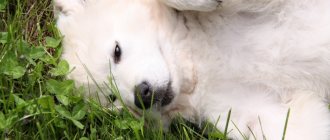Pekingese - a small indoor dog, bred in China and until the 18th century was considered pet exclusively emperors and their entourage.
In the 18th century, the breed was exported by the British outside the country and began to gain popularity in Europe.
The Pekingese is famous for its independent and capricious character , but with proper upbringing, it is an intelligent and kind creature to everyone around it. Pekingese dogs do not like fuss , but they value routine and leisurely activities.
It’s worth mentioning separately about the coat - these dogs have long, thick hair with a soft undercoat that prevents them from freezing in the coldest weather, so walking in winter (as well as in summer) is carried out without overalls.
Pekingese - features of the breed
Before purchasing a puppy, the potential owner needs to study all the features of the breed. Practice shows that many people know the positive aspects of breeds, but possible problems remain unnoticed. The Pekingese is no exception; it is a wonderful, but often problematic breed that requires special care.
The main weaknesses of the Pekingese are:
- Eyes.
- Airways.
- Mucous membranes.
- Leather.
- Wool.
- Hormonal imbalances.
Nutrition is not related to only two of the above points. Breathing problems occur due to an elongated, soft palate. Animals that are not castrated and do not participate in breeding are prone to hormonal imbalances, including consequences such as mastitis, pyometra, cancer of the uterus, ovaries/testicles and mammary glands.
Chronic and acute conjunctivitis and otitis media can be caused by an improper diet, especially by eating foods containing sugar. Skin and coat problems develop against the background of allergies. By the way, Pekingese are prone to both food and atopic allergies. Poor coat is a consequence of vitamin deficiency, disruption of the hormonal system or parasites.
Note! With unbalanced feeding, Pekingese often gain excess weight.
Neonatal (birth to two weeks)
This period lasts 12 days. After the bitch gives birth, the embryonic period of puppy development ends. Babies are born blind and deaf, but have taste and touch. The newborn is not physically independent, reacts only to the smell of the mother, heat and cold.
During this time, the Pekingese feeds exclusively on mother's milk, is practically unable to regulate heat exchange and is incapable of defecation. The weight of a newborn is about 150-250 g.
Choosing a place and utensils for feeding
An important role in proper feeding is played by the choice of place and dishes for the Pekingese puppy. Absolutely all puppies have a tendency to play enthusiastically and suddenly remember that they really want to eat. The puppy drops everything and literally flies to the bowl. Emergency braking on a slippery kitchen floor leads to slipping, somersaults and other tricks. This situation is fraught with injury, especially when it comes to miniature and very large puppies.
To keep your Pekingese puppy safe, make the eating area non-slip. The simplest method is to cover the floor with a special rubber mat. In addition to being comfortable for your puppy, the mat is easy to clean to keep the eating area clean.
How to choose the right bowls? Because Pekingese have short faces, the bowl should be wide and shallow. In order for a dog to take food from a bowl, it needs to open its mouth completely, take this into account when choosing a bowl based on its diameter.
You don't need to buy a stand for your Pekingese puppy's bowls, but make sure they don't slide around on the floor. Give preference to stainless steel or ceramic bowls. Ceramic bowls are heavier and do not slip on the floor. Stainless steel bowls are easier to clean and can be boiled.
Standard
The standard (FCI-Standard N° 207) describes in great detail the ideal representative:
- Height no more than 25 cm. Weight up to 5.5 kg, and this is the maximum weight of a female. Males usually weigh up to 5 kg. The general impression is that of massiveness, strong bones and a solid structure are required.
- The head is large, wide, the transition between the bridge of the nose and the bridge is pronounced, almost 90 degrees.
- The eyes are bulging, widely spaced, round, and always dark.
- The ears are heart-shaped, set on the top of the skull, close to the cheekbones, and no longer than the muzzle.
- The nose is black, the nose itself is wide, with large open nostrils turned forward. A wide fold in the form of an inverted V is required, from the bridge of the nose to the cheekbones, but not excessive and not obstructing the view.
- The muzzle is short, distinct and wide, with a pronounced lower jaw. The lips fit tightly to the jaw and do not cover the chin.
- The neck is short and thick, but it holds its head majestically and evenly.
- The body is short, with a pronounced waist, broad chest.
- The limbs are short, thick, the elbows fit tightly to the body.
- The tail is set high and constantly thrown over the back so that it touches it.
The movements are clear and confident, but at the same time imposing and a little waddling. The Pekingese walks slowly, does not like to run or jump, but should not show any signs of weakness.
If the need to demonstrate this arises, he will be resilient.
Coat and colors
The coat is straight and of moderate length. There is a pronounced mane on the shoulders, feathering on the back of the legs and on the tail. At the same time, the fur does not hide the movements and does not interfere with the dog. It has two layers: a soft undercoat and a hard outer coat.
The standard is very lenient when it comes to colors. Any options are acceptable, except for albinos and liver-colored individuals. The former are not allowed to compete because they often have mental defects, the latter because their lips and eyelids have a brown tint.
There are several most common colors:
All representatives of the breed have a black muzzle and black edging of the ears. Puppies without these markings are rarely born and are subject to disqualification.
What to feed a Pekingese puppy - choosing the type of diet
When choosing what to feed your Pekingese puppy, you need to choose between:
- Natural feeding.
- Industrial feeding.
- Mixed feeding.
Each type of feeding has advantages and disadvantages. Let's take a closer look.
Natural diet
A natural diet for a Pekingese puppy includes:
- Feeding raw and cooked foods.
- Feeding meat porridge.
- Feeding exclusively raw foods is a raw food diet.
Traditionally, based on experience, veterinarians recommend feeding dogs with natural products.
Varieties: Chinese, royal, imperial (photos)
On message boards you can often see similar publications: “Imperial Pekingese puppies”, “real Chinese Pekingese”, “Royal Pekingese” - all this is nothing more than a publicity stunt.
If we talk about purebred and standard, then there are no varieties of Pekingese.
However, they really got a dog “like the emperor,” because he also had an ordinary Pekingese.
Also, many people confuse Japanese Chins with Pekingese, believing that these are two varieties of the same breed. It's not like that at all. They differ in everything - from external parameters to character traits.
Be sure to pay attention to this when choosing a pet.
Sample menu by age for a Pekingese puppy
By creating a sample menu by age for a Pekingese puppy, you will be able to assess your capabilities and potential benefits when choosing a particular type of food. If you doubt that you can afford to feed your puppy ready-made food, it is better not to experiment and stick to a natural diet.
Important! It is highly undesirable to change the type of diet of a Pekingese puppy suddenly and without reason. This measure is valid if the puppy has received poor quality food or has an allergy. In other cases, the transition to another type of nutrition should occur gradually.
Under the age of one month
Until the age of one month, a Pekingese puppy should receive exclusively mother's milk or a milk substitute. Mother's milk is more than just nutrition! With milk, puppies receive beneficial bacteria and antibodies, which form their first immunity.
If your Pekingese puppy had to be artificially fed, you can use natural products to:
- Homemade goat milk, diluted with boiled water.
- Nutritional mixture based on goat milk, glucose, yolk.
Industrial menu for a Pekingese puppy up to a month old
- Bitch milk substitute.
- From two weeks of age - infant formula without additives.
The serving size for a Pekingese puppy under the age of one month depends on the size and usually ranges from 15 to 40 grams. Until the age of 1 month, Pekingese puppies should receive food on demand.
The standard feeding scheme looks like this:
- From birth to 2 weeks, Pekingese puppies eat every 2 hours.
- From 2 to 4 weeks of age, Pekingese puppies eat every 2–3 hours, with a nighttime break of 4–6 hours.
Note! If there are 1-2 puppies in the litter, the mother's milk will be fattier and richer, as a result of which the babies will eat less often.
1 month
At 1 month, the Pekingese puppy is given its first complementary food. If you are leaning towards a natural type of nutrition, your diet should consist of:
- Mother's milk.
- Whole goat or cow's milk.
- Low-fat broth.
- Boiled minced meat mixed with broth.
Owner reviews
Ksenia:
“Very friendly dogs, good with children. We have had a pair of Pekingese dogs at home for five years now. It’s not difficult to care for them, the main thing is not to mess around, but to walk them for a long time. Otherwise, the dog may wither away right before our eyes.”
Maria
“I have been breeding dogs for a long time. I had to work with different breeds. Pekingese are one of my favorites. Very unpretentious, kind, in demand among clients. They adopted such a puppy into their family.”
All photos
The Pekingese is a small, flat-faced breed of toy dog bred in China.
Briefly about the breed
- Name: Pekingese, Pekingese
- Other name: Chinese Spaniel, Peking Palace Dog
- Lifespan: 12-15 years
- Weight: males 3.2-5.0 kg, females 3.6-5.4 kg
- Height (height at withers): 15-25 cm
- Puppy price: pet class – 10-15 thousand rubles, breed class – 20 thousand, show class – 30 thousand rubles
Vitamins and supplements in the diet of a Pekingese puppy
When choosing a natural type of feeding for your Pekingese puppy, be sure to include vitamins and supplements in his diet. Until the age of one, vitamins should be given every day. When the dog exits the active growth stage, vitamins are given in courses. If you are feeding your puppy high-quality commercial food, you do not need to give additional vitamins unless they have been prescribed by your veterinarian.
Many vitamins are found in natural foods. When enriching your diet, remember that moderation is important in everything - an excess of vitamins is just as harmful as their deficiency.
Natural vitamin supplements for Pekingese puppy:
- Meat and bone meal.
- Clean, dried, crushed egg shells.
- Bran.
- Fish, chicken, beef liver.
- Greens, vegetables, fruits.
- Sunflower oil, olive oil.
- Brewer's yeast.
In addition to natural sources of nutrients, you can add pharmaceutical products to your Pekingese puppy's food:
- Fish fat.
- Feed tricalcium phosphate.
- Omega-3, Omega-6.
- B vitamins.
- Undevit and analogues.
If you forget to give your puppy vitamins or doubt that you will calculate the dosage correctly, it is better to switch to industrial complexes. Vitamins for puppies are available in the form of tablets, crackers, powder, etc. Tablets and crackers can be used as a treat; the powder is poured into the porridge before serving.
Character
If you look at the Pekingese, you might think that it is a weak and defenseless animal, but this is not so. Despite their appearance, these are brave dogs with the pride of a lion, royal dignity and independence.
They are owners and love it when their owner pays attention only to them. This breed is not recommended for families with small children.
Selfish in love. Dog jealousy can manifest itself in small pranks and troubles. Dogs of this breed are playful, friendly and loyal, without anger or aggressiveness, but very touchy.
At the same time, they will boldly rush to protect the owner, despite their size. The character is not simple and difficult to train. It will take a lot of patience, time and treats for the dog.
Water in a puppy's diet
Water plays a major role in a puppy’s diet. If there is a lack of water, the puppy quickly develops:
- Blood thickening.
- Slowing metabolism.
An adult dog can withstand the above factors for several days, but a puppy risks dying in a matter of hours. What should you do to avoid putting your Pekingese puppy in danger? Buy 2-3 water bowls at once. Place drinking bowls in areas to which the baby has constant access. Be sure to make sure your puppy drinks water, especially if he is not yet 2-3 months old. At this age, puppies are reluctant to drink, even if they are thirsty.
What causes coat change in general?
This process is called “age molting” and is completely natural. It is not difficult to understand that coat change begins at a certain age. In addition, there are several age groups, i.e. The pet's fur will change gradually and in stages.
Why does nature provide for a change of coat? It's simple. Initially, puppies require thick and soft fur, which protects them from temperature changes and allows them to retain body heat, provided that initially the pet’s thermoregulation systems do not work.
With age, the thermoregulation system of a young animal “comes to life”, after which the dog is no longer in danger of freezing at room temperature. Accordingly, the wool becomes coarser, as it turns into a universal protective cover, playing the role of not only “insulation”, but also “clothing” that protects the skin. In addition, among the ancestors of dogs, fur was a means of camouflage.
Prohibited foods for a Pekingese puppy
It is important to exclude prohibited foods from your Pekingese puppy’s diet:
- Bones, pure fat, skin, especially poultry.
- Palm oil.
- Grapes, raisins.
- Soy.
- Mushrooms.
- Corn and semolina.
- Raw freshwater fish.
- Dry, salted fish.
- Products containing sugar or sugar substitutes.
- Products containing xylitol (chewing gum, some sweets).
- Products containing flour or yeast.
- Products containing caffeine, cocoa, any stimulants (sweets, tea, coffee, chocolate).
- Products containing marinades, salt, spices.
- Smoked products, including sausages, balyki, fish.
- Expired products.
- Leftovers from the table.
In addition to the prohibited ones, there is a list of controversial products that may be prohibited due to individual intolerance or allergies:
- Lean raw pork.
- Raw ocean fish.
- Whole milk.
- Honey.
- Chicken eggs.
- Raw and boiled chicken liver in large quantities.
Be careful, as acute reactions to controversial foods can occur suddenly in your Pekingese puppy.
For example, absolutely all puppies up to 4–5 months of age drink milk with pleasure. At older ages, approximately 40% of puppies develop lactose intolerance.
Socialization (4-12 weeks)
The dog begins to master social behavior skills. All physiologically important functions are formed, but the baby continues to actively grow.
By the end of the 5th week, the puppy begins a gradual weaning from its mother, which ends at 7-10 weeks. The dog's weight increases to 1.5-2 kg. His first teeth erupt, he begins to taste solid food, gnaw on objects and bite. Physical activity increases sharply.
The Pekingese develops its character, develops reactions to potential danger, and begins to actively communicate and learn about the world around it.
Play activity plays an important role in the development of a dog’s mental activity. Games can be single or group. During play activities, the puppy’s motor skills develop and social behavior is formed.
This stage is dangerous due to physical and mental injuries. Therefore, the dog cannot be punished, but on the contrary, communicate more and teach it to communicate with a person (video author Irina Kuzmina).
Usual timing of shedding
It is believed that there are two “standard” age shedding patterns for the average dog:
- Puppies shed their first coat when they are about two months old. By this time, puppy fluff gives way to teenage fur. In its structure, the latter is already close to the adult coat. Note that in almost 90% of cases this can be seen with the naked eye, since juvenile fur is significantly different in color from “baby” fluff.
- Complete replacement with adult hair begins around the age of six months. Starting from this period, the cover becomes more and more rough and “seasoned”.
But! You should not assume that a six-month-old puppy will immediately develop adult hair. As a rule, this takes several lines. This is especially pronounced in representatives of long-haired breeds with an undercoat of complex “design”.
It takes a long time for the adult coat to change for Newfoundlands, Afghan hounds, and St. Bernards. But short-haired pets “change clothes” much faster: in most cases, at the age of one, they already have a full-fledged adult coat.
